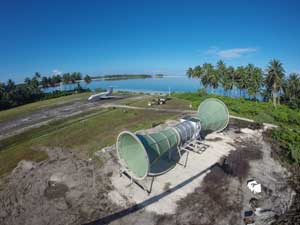The Nature Conservancy has completed a $1.2 million renewable energy project, installing solar and wind systems that will almost eliminate the use of fossil fuels at Palmyra Atoll.
“Installing solar and wind energy at Palmyra will reduce our dependence on fossil fuels by 95%,” said Mark Fox, acting executive director of the Conservancy’s Hawaii and Palmyra programs. “It will eliminate an annual 21,000-gallon shipment of diesel fuel previously used to run the atoll’s generators.”

The Nature Conservancy installs SheerWind’s Invelox system on Palmyra Atoll. Photo Credit: Andrew Purves
Selecting a turbine
While installing the photovoltaic system was fairly straight forward, finding and installing a suitable wind turbine to power the station at night and on cloudy days proved difficult. Because Palmyra is home to more than a million nesting seabirds, conventional wind turbines were not an option due to the risk the of bird strikes.
The Conservancy turned to the Minnesota firm SheerWind’s Invelox design, which resembles an hourglass turned on its side. Extending 83 ft horizontally with big wind scoops at either end, the design uses a Venturi system that increases wind speed three to six times, with nets over the intake and enclosed blades that keep it bird friendly.
David Sellers, the Conservancy’s acting Palmyra director and a trained architectural engineer, took that design and transformed it into a physical reality, overseeing the design, fabrication and construction of the turbine in Honolulu before shipping it in sections to Palmyra.
“The wind turbine gives us a diversity of power sources, which is really important in a remote location,” he said. “We cannot rely on just one system.” For extra backup, the Conservancy maintains a three-year supply of bio-diesel made from 100% recycled vegetable oil to run the existing generators.
Planning and funding
Jacob Freeman, president of Maui-based CDF Engineering and the project’s volunteer engineer, said the installation required three years of careful planning. Every piece of equipment, every tool, every screw and every electrical switch and fuse needed to be on hand, on island, along with replacement parts.
“Our motto was, ‘There is no Home Depot on Palmyra,’” said Freeman, who donated $120,000 in CDF Engineering labor to the project.
The project’s low $1.2 million cost was made possible by the generous financial and in-kind support of numerous companies and individuals, including Conservancy trustees and supporters from Oregon, Montana and Hawaii, who donated more than $500,000. Substantial initial design work was provided by R.P. Delio & Co. SunEdision donated the solar panels, while in-kind gifts from Big Ass Fans, R and R Solar Supply, Shobu’s Refrigeration, SMA America, Torqeedo and the U.S. Fish and Wildlife Service (USFWS) enabled the Conservancy to retrofit the station with LED lights, dc low-voltage fans, dc inverter air conditioners and electric vehicles.
Why renewable energy?
Located 1,000 miles south of Hawaii, Palmyra hosts spectacular coral reef and tropical island ecosystems, but is a challenging place for humans to operate. There are no commercial flights to this remote outpost, which is co-owned and managed as a scientific research station and national wildlife refuge by The Nature Conservancy and the USFWS.
Buying and shipping the diesel fuel needed to run the research station took up more than half of the Conservancy’s operating budget for Palmyra and produced 349 tons of CO2 annually. Including shipping, fuel costs were between $11 and $13 a gallon. “That’s about $0.93 per kWh for our energy needs. The average cost on the U.S. mainland is $0.12,” said Sellers.
In 2012, the Conservancy substituted bio-diesel for regular diesel to power the atoll. And while it proved a clean and effective alternative, it wasn’t any cheaper to purchase and ship than regular diesel. That’s when the Conservancy decided to take Palmyra renewable. The six-week project saw Conservancy staff and a crew of 30 volunteers install 385 solar panels, a solar hot water system, a deep-cycle battery system to store sunlight for use at night, and a prototype bird-friendly wind turbine—all of it creating a custom 100-kW solar micro-grid. The atoll is now running almost entirely on renewable energy.
Moving forward
Completion of the renewable energy system marks another milestone for Palmyra. Since coming under joint ownership of the Conservancy and the USFWS in 2001, the 680-acre atoll and the marine environment surrounding it are now a USFWS national wildlife refuge, a marine national monument and an international research station attracting scientists from Stanford, Scripps Institution of Oceanography and other top universities and research institutions.
“The commitment to making the station sustainable reflects the long term dedication that the USFWS and the Conservancy share in protecting the rich natural resources and biodiversity found at Palmyra,” said Stefan Kropidlowski, the Palmyra Atoll Refuge manager for the USFWS.
“With the renewable energy system in place, we can now focus on what we do best—conservation and scientific research to inform that conservation,” said Fox. “Going forward, we will work with the USFWS to ensure that the renewable energy systems have little to no negative impact on the atoll’s wildlife and habitat.”
“We have basically locked in 20 years of low-cost energy and made the station economically and environmentally sustainable,” added Sellers. “Our carbon footprint has been reduced dramatically. And we have mitigated the environmental risk of having to transport and store all that fuel.”
SheerWind
sheerwind.com
Filed Under: News, Projects




